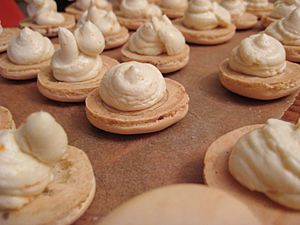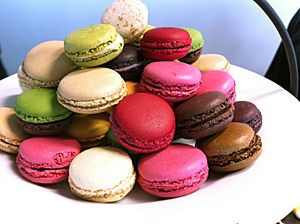Macaron facts for kids
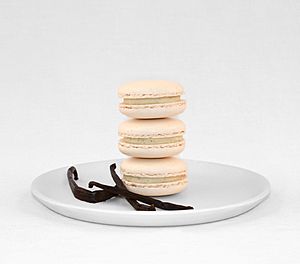
Parisian-style macarons (vanilla flavour)
|
|
| Alternative names | French macaroon |
|---|---|
| Type | Confectionery |
| Place of origin | France |
| Created by | Pierre Desfontaines or Claude Gerbet |
| Main ingredients | Cookie: egg white, icing sugar, granulated sugar, almond powder, food colouring Filling: buttercream or clotted cream, ganache, or jam |
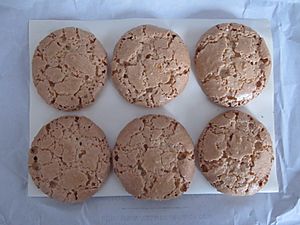
A macaron (pronounced MAK-ə-RON) is a delightful, sweet treat. It's a small, round cookie made from egg white, icing sugar, granulated sugar, and finely ground almond meal. Often, a touch of food colouring gives macarons their vibrant look.
Since the 1800s, the most famous type of macaron, from Paris, has been a sandwich cookie. It has a yummy filling like ganache, buttercream, or jam between two meringue-based shells. These cookies have a smooth top, a ruffled edge called the "foot," and a flat bottom. They are slightly moist and melt in your mouth. Macarons come in many exciting flavours, from classic raspberry and chocolate to more unusual ones.
Contents
What is a Macaron?
Macarons are a type of confectionery that looks like a small, colourful sandwich. Each macaron has two delicate, crispy shells. These shells are made from a special mixture of egg white, sugar, and ground almonds. They are baked until they have a slightly chewy texture.
Between the two shells, there's a delicious creamy filling. This filling can be buttercream, a rich chocolate ganache, or sweet jam. The combination of the crisp shell and soft filling makes macarons a unique dessert. They are known for their beautiful colours and wide range of flavours.
Macaron vs. Macaroon: What's the Difference?
It's easy to confuse "macaron" with "macaroon," but they are different! A macaron is the delicate, colourful sandwich cookie we're talking about. It's made with finely ground almonds.
A macaroon (pronounced MAK-ə-ROON) is usually a chewier, often coconut-based cookie. It looks more rustic and doesn't have a smooth, sandwich-like appearance. In North America, people often use the French spelling "macaron" to clearly tell them apart. Both names come from the Italian word "maccheroni," which referred to a type of paste.
The Sweet History of Macarons
The modern sandwich-style macaron was created in Paris. However, the idea of almond-based sweets goes back much further.
Early Beginnings: Almond Sweets
Around 827 AD, Arab people from North Africa arrived in Sicily. They brought with them delicious nut-based sweets. These treats, like fālūdhaj and lausinaj, had sweet almond cream inside. They were popular in ancient Persia during celebrations like Nowruz, the Zoroastrian New Year. In places like Sicily and Toledo, Spain, these almond sweets evolved into desserts like marzipan.
Some food historians believe macarons might have started in a French monastery. This was in Cormery in the Loire Valley around 791 AD. These early versions were simple cookies made with egg whites, sugar, and almonds. Another story suggests they came from al-Andalus (parts of modern Spain) to Marrakesh (in Morocco) in the early 11th century. They were often served during Ramadan.
A popular story says that Catherine de' Medici brought macarons to France. She was an Italian noblewoman who became Queen of France. However, records don't show any Italian chefs working with her who would have introduced them.
Macarons in France: Nuns and Bakers
In the 1790s, macarons became more widely known in Nancy. During the French Revolution, two Carmelite nuns needed a safe place to stay. They baked and sold these almond cookies to earn money for their housing. People started calling them the "Macaron Sisters." At this time, macarons were plain, without special flavours or fillings.
It wasn't until the 1930s that macarons started to be served as sandwich cookies. Bakers began adding delicious fillings like jam, liqueurs, and spices. The macaron we know today, with two almond meringue discs and a filling, was sometimes called the "Gerbet" or "Paris macaron." Pierre Desfontaines of the famous French bakery Ladurée is often credited with making them popular in the early 1900s. Another baker, Claude Gerbet, also claimed to have invented this style. French macaron bakeries became very popular in North America in the 2010s.
How Are Macarons Made?
Making macarons is a bit of an art! There are two main ways to prepare the meringue, which is the base of the cookie. These are the French method and the Italian method.
French Method
In the French method, egg whites are whisked until they form stiff peaks. This creates a light and airy meringue. Then, finely ground almonds and powdered sugar are gently folded into the meringue. This careful mixing, called "macaronage," helps create the perfect texture.
Italian Method
The Italian method starts by whisking egg whites with hot sugar syrup. This makes a very stable meringue. Separately, ground almonds and icing sugar are mixed with raw egg whites to form a paste. Finally, the meringue and almond paste are combined. This method often results in a more sturdy macaron shell. It also requires a candy thermometer to get the sugar syrup just right.
Vegan Option
For those who don't eat eggs, there's a vegan way to make macarons. Instead of egg whites, a liquid called aquafaba is used. Aquafaba is the liquid from canned chickpeas. All other ingredients are generally the same.
After the mixture is ready, it's piped onto baking sheets. It then rests for a while to form a slight skin. This helps create the famous "foot" when baked. Once baked, a delicious filling is added.
Macarons Around the World
Macarons are loved all over the globe, and different places have their own special versions.

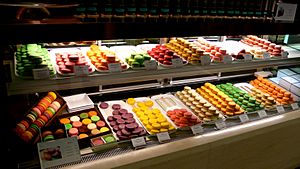
French Macarons: Regional Delights
Many French cities have their own macaron traditions. In Amiens, they make "Macarons d'Amiens." These are small, round, biscuit-like cookies made with almond paste, fruit, and honey. They have been around since at least 1855.
The city of Montmorillon is famous for its macarons and even has a museum about them! The oldest bakery there, Maison Rannou-Métivier, has been making them since 1920. Their traditional recipe has stayed the same for over 150 years.
The town of Nancy also has a rich macaron history. Two nuns, Sisters Marguerite and Marie-Elisabeth, are said to have created the Nancy macaron. They needed a special recipe that fit their strict diet. They became known as the "Macaron Sisters."
Macarons in Asia: India and Japan
In Thoothukudi, Tamil Nadu, India, they have their own unique macaron. It's made with cashews instead of almonds. This version came from macarons introduced during colonial times.
In Japan, macarons are very popular and are called makaron. There's also a version that uses peanut flour instead of almond flour. These makaron often have traditional Japanese flavours. They are even a fashion trend, appearing on phone accessories and cosmetics.
Swiss Luxemburgerli
In Switzerland, a famous type of macaron is called Luxemburgerli. These are made by Confiserie Sprüngli in Zürich. Luxemburgerli are smaller and lighter than many other macarons. They have two almond meringue disks with a creamy buttercream filling.
American Flavors
Pastry chefs in the United States have gotten very creative with macarons. They've invented many exciting flavours. You can find everything from mint chocolate chip and peanut butter and jelly to Snickers and salted caramel popcorn macarons!
South Korean Fat-carons
South Korea has a popular variation called "fat-carons" (or ttungcarons). Bakers intentionally add a lot of filling to these macarons. They often decorate them too, making them look like small ice cream sandwiches.
Why Are Macarons So Popular?
Macarons are a global sensation! In Paris, the Ladurée pastry shops have been famous for their macarons for about 150 years. They are known for their beautiful presentation and delicious flavours.
Even McDonald's sells macarons in its McCafés in many countries. These include Portugal, Spain, Australia, France, Belgium, Switzerland, and New Zealand. Sometimes, their ads even compare the macaron's shape to a tiny hamburger! These McCafé macarons are made by Château Blanc, a company related to Ladurée.
Outside of Europe, French-style macarons are very popular in Canada and the United States. In Australia, TV shows like MasterChef Australia and chefs like Adriano Zumbo helped make macarons a trendy sweet treat.
 In Spanish: Macarrón (galleta) para niños
In Spanish: Macarrón (galleta) para niños
- Macaroon
- Sandwich cookie
- Alfajor – a similar Spanish confection
- Petit four
- Empire biscuit
- Fudge cookie
- Jammie Dodgers
- List of almond dishes


